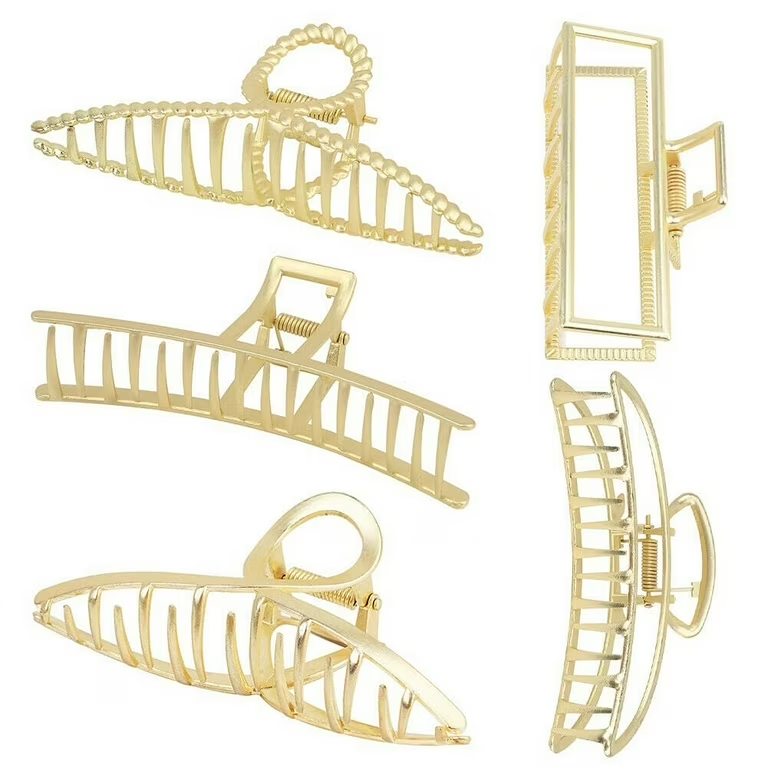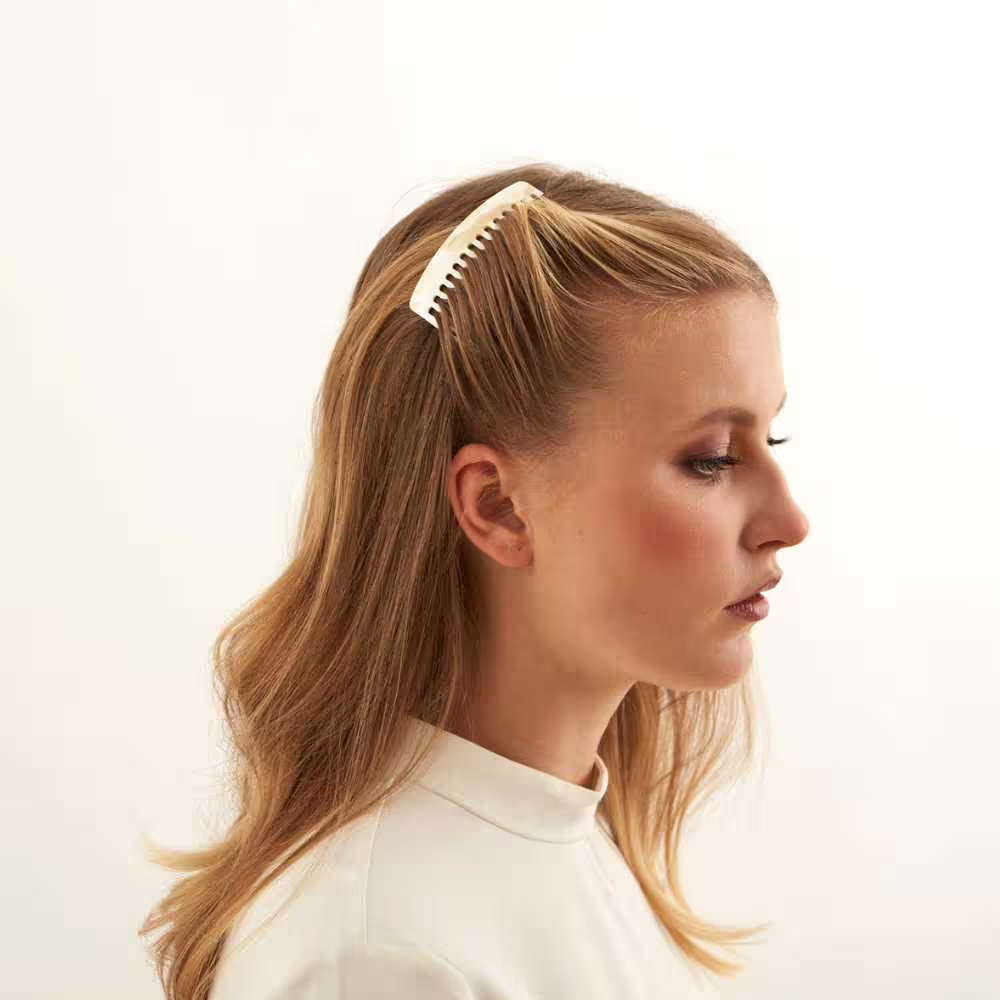
Metal Hair Clips: Functionality Meets Style
The Evolution of Metal Hair Clips
Metal hair clips have adorned heads for centuries, evolving from simple functional tools to fashionable accessories. Ancient civilizations used bone, wood, and eventually metal to secure hairstyles, with archaeologists discovering ornate hair clips in Egyptian tombs and Greek ruins. As metalworking techniques advanced, so did the intricacy and variety of hair clips. The Victorian era saw a boom in decorative metal hair accessories, with elaborate designs featuring precious metals and gemstones.
The 20th century brought mass production, making metal hair clips accessible to the general public. From the sleek barrettes of the 1920s to the colorful snap clips of the 1990s, metal hair clips have consistently reflected the fashion trends of their time. Today, these versatile accessories continue to adapt, blending traditional designs with modern aesthetics. The durability and malleability of metal allow for endless possibilities in shape, size, and decoration, ensuring that metal hair clips remain a staple in hair fashion for years to come.

Types of Metal Hair Clips
The world of metal hair clips offers a diverse range of styles to suit every preference and hair type. Bobby pins, with their simple, u-shaped design, provide discreet hold for updos and intricate styles. Barrettes, featuring a hinged clip mechanism, come in various sizes and designs, from minimalist to ornate, perfect for securing half-up styles or adding a decorative touch. Claw clips, with their curved shape and interlocking teeth, effortlessly create casual updos and hold thick sections of hair.
French clips, also known as auto clips, use a spring mechanism for a secure grip and come in both plain and decorative versions. Snap clips, popular for their ease of use, add a playful touch to any hairstyle. Decorative pins and sticks, often featuring intricate metalwork, serve both functional and aesthetic purposes in formal hairstyles. Each type of metal hair clip offers unique benefits, allowing users to experiment with different looks and find the perfect solution for their hair needs.
Materials and Manufacturing Processes
The production of metal hair clips involves a variety of materials and manufacturing techniques. Common metals used include stainless steel, aluminum, brass, and copper, each chosen for its specific properties such as durability, malleability, or resistance to corrosion. High-end clips often feature precious metals like gold or silver. The manufacturing process typically begins with metal sheets or wire, which are cut, shaped, and formed using techniques such as stamping, die-cutting, or wire-forming. For more complex designs, casting methods may be employed.
Surface treatments like polishing, plating, or anodizing enhance the appearance and durability of the clips. Many manufacturers incorporate additional materials such as enamel for color, rubber or silicone for grip, or crystals and gemstones for decoration. The production of metal hair clips often combines automated processes with handcrafting, especially for high-end or artisanal pieces. Quality control measures ensure that each clip meets standards for durability, functionality, and safety, particularly important for items that come into direct contact with hair and skin.

Styling Tips and Tricks with Metal Hair Clips
Metal hair clips offer versatility in styling, suitable for a wide range of hair types and lengths. For fine hair, small bobby pins or delicate barrettes can add subtle hold without weighing down the hair. Those with thick or curly hair might opt for sturdy claw clips or large barrettes to secure voluminous styles. To create a sleek look, use multiple bobby pins in a crisscross pattern for extra hold. For a bohemian vibe, scatter small decorative clips throughout loose waves.
Claw clips excel at creating effortless updos: simply twist the hair and secure it at the back of the head. Experiment with asymmetrical placement of barrettes for a modern, edgy look. Layer different sizes and styles of clips for a trendy, maximalist effect. Use metal clips to secure braids or as decorative endpoints for plaits. For formal occasions, incorporate jeweled or ornate metal clips into sophisticated updos. Remember to spray bobby pins with dry shampoo or texturizing spray for extra grip in slippery hair. With creativity and practice, metal hair clips can elevate any hairstyle from mundane to magnificent.
Care and Maintenance of Metal Hair Clips
Proper care and maintenance of metal hair clips ensure their longevity and continued effectiveness. Regular cleaning prevents buildup of hair products, oils, and debris that can affect the clip’s performance and appearance. For most metal clips, a simple cleaning with warm water and mild soap, followed by thorough drying, suffices. For more stubborn residue, a soft-bristled brush can help remove buildup without scratching the metal surface.
Avoid exposing metal clips, especially those with decorative finishes or non-metal components, to harsh chemicals or excessive moisture. Store clips in a dry place to prevent rust or tarnishing. For clips with hinges or moving parts, occasional lubrication with a drop of mineral oil can maintain smooth operation. Inspect clips regularly for signs of wear, such as bent prongs or loose stones, and replace them if they no longer hold securely to prevent damage to the hair. With proper care, high-quality metal hair clips can last for years, making them a worthwhile investment for any hair accessory collection.

The Fashion Impact of Metal Hair Clips
Metal hair clips have made a significant impact on fashion trends throughout history. In recent years, a resurgence of 90s and Y2K aesthetics has brought playful snap clips and minimalist barrettes back into the spotlight. High-fashion runways have showcased elaborate metal hair accessories, inspiring everyday styles. Celebrities and influencers often use statement metal clips to complete their red-carpet looks or casual street styles, driving trends and inspiring followers.
The versatility of metal clips allows them to complement various fashion aesthetics, from sleek and modern to vintage and romantic. Designers frequently incorporate metal hair clips into their collections, creating cohesive looks that extend beyond clothing. The accessibility of metal clips, ranging from affordable drugstore options to luxury designer pieces, makes this trend adaptable to various budgets and style preferences. As fashion continues to cycle and evolve, metal hair clips remain a constant, reinventing themselves to fit contemporary tastes while maintaining their timeless appeal.
Cultural Significance of Metal Hair Clips
Metal hair clips hold cultural significance in many societies around the world. In some Asian cultures, ornate metal hair sticks and pins play important roles in traditional hairstyles, often symbolizing marital status or social position. Native American cultures have long used metal hair accessories, including clips and cones, in ceremonial and everyday wear, often incorporating meaningful symbols and materials. In Western cultures, certain styles of metal clips have become associated with specific subcultures or time periods, such as the victory rolls secured with metal pins popularized during World War II.
The exchange and gifting of decorative metal hair clips hold sentimental value in many cultures, marking important life events or relationships. In some professional settings, the choice of metal hair accessories can convey adherence to dress codes or attention to detail. The global popularity of metal hair clips demonstrates their universal appeal, transcending cultural boundaries while still retaining unique significance within different contexts.
Sustainability and Ethical Considerations
As awareness of environmental and ethical issues grows, the production and consumption of metal hair clips face increased scrutiny. Sustainable practices in manufacturing involve using recycled metals, minimizing waste, and employing energy-efficient processes. Some companies focus on creating durable, high-quality clips designed to last, countering the throwaway culture associated with fast fashion accessories. Ethical considerations extend to labor practices in the production chain, with consumers showing interest in clips made under fair working conditions.
The use of alternative, eco-friendly materials in conjunction with metal, such as biodegradable plastics or sustainable wood, offers innovative solutions to reduce environmental impact. Additionally, the trend of upcycling vintage metal clips aligns with sustainability goals, giving new life to old accessories. Consumers can contribute to sustainability by choosing quality over quantity. Properly maintaining their clips to extend their lifespan, and responsibly disposing of or recycling old metal clips. As the industry evolves, balancing style, functionality, and ethical production will likely drive innovation in metal hair clip design and manufacturing.

DIY and Customization of Metal Hair Clip
The world of DIY and customization opens up endless possibilities for personalizing metal hair clip. Crafting enthusiasts can create unique pieces using readily available metal components and simple tools. Wire-wrapping techniques allow for the creation of intricate designs, while metal stamping can add personalized text or patterns to plain clips. Embellishing store-bought metal clips with beads, rhinestones, or enamel paint offers an easy way to refresh old accessories or create custom designs.
For those with metalworking skills, techniques like soldering can join different elements to form complex, one-of-a-kind pieces. Upcycling old jewelry or repurposing other metal objects into hair clips provides a sustainable and creative outlet. Online tutorials and workshops have made these DIY techniques more accessible. Fostering a community of creators who share ideas and inspiration. The ability to customize metal hair clip allows for expression of personal style. Creation of meaningful gifts, or even the start of small businesses centered around handcrafted accessories.
The Future of Metal Hair Clip
The future of metal hair clips looks bright, with innovations in design, technology, and materials driving the industry forward. Smart hair clip incorporating technology, such as those with built-in UV sensors or fitness tracking capabilities, may become more prevalent as wearable tech evolves. Advances in metallurgy could introduce new alloys with enhanced properties, such as improved flexibility or heat-responsive elements. 3D printing technology may revolutionize the production of metal clips, allowing for intricate designs and custom-fit accessories.
The growing interest in sustainable fashion might lead to increased use of recycled metals and eco-friendly production methods. As hairstyles and fashion trends continue to evolve, metal hair clip will likely adapt, potentially incorporating modular designs for versatility or integrating with other hair accessories for multifunctional use. The timeless appeal of metal, combined with ongoing innovations, ensures that metal hair clip will continue to play a significant role in both everyday hairstyling and high fashion for years to come.

